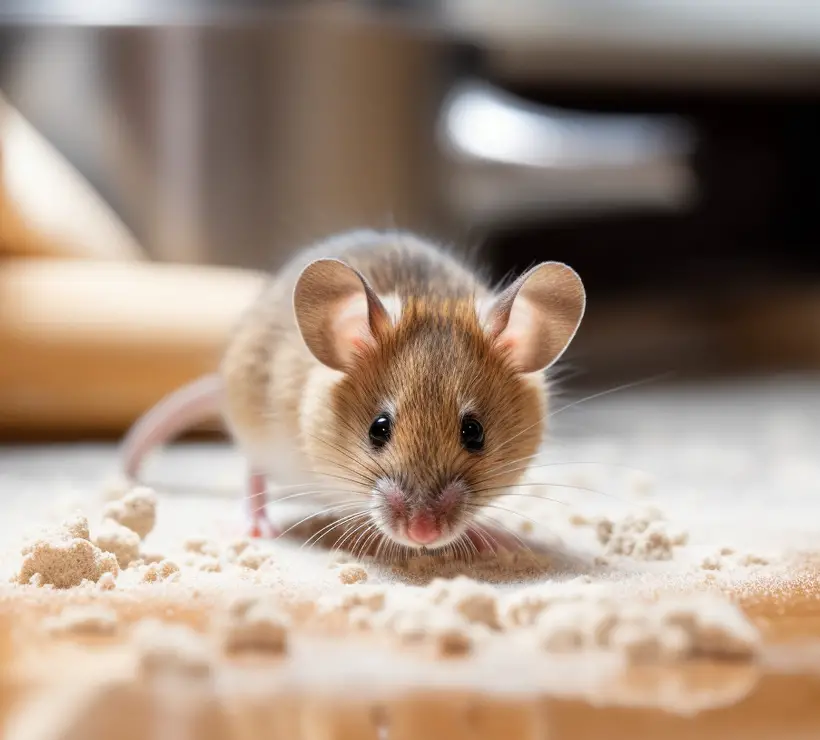Signs of Mice But no Droppings: Why Mice Suddenly Disappears?
The presence of mice is often indicated by various signs, such as gnaw marks, chewed wires, and strange noises. However, one puzzling situation that homeowners encounter is the presence of signs of mice but no droppings.
So, why mice suddenly disappear? Signs of mice but no droppings include
- Limited time spent in an area
- Regular home cleaning
- Repellents and deterrents
- Unusual nesting habits
- Infestation stage and presence of young mice
This article aims to explore the reasons behind this phenomenon. Also, to shed light on why mice suddenly disappear without leaving their droppings behind.
Description of Mice Droppings
If you spot a mouse in your house, looking for its droppings is important. Mouse droppings are usually black, rod-shaped, and about the size of a grain of rice, measuring between 1/8″ and 1/4″ long.
They are soft and moist upon being expelled, but over the course of approximately a day, they dry up and harden. On the other hand, rat droppings, being about as large as a thumbnail, exhibit similar characteristics.
The Stealthy Nature of Mice
Mice are incredibly agile and have an instinct for self-preservation. They are nocturnal creatures that prefer to remain hidden during the day and emerge under the cover of darkness to search for food and water.
Due to their small size, mice can easily squeeze through tiny openings and find secluded areas within our homes to establish their nests.

They choose unconventional spots like walls, appliances, or furniture where their droppings are not easily visible to homeowners. They are masters of stealth, which allows them to move undetected, making it difficult to spot their droppings.
Signs of Mice But no Droppings
There may be signs of mice but no droppings for several reasons. Here are some possible explanations.

Limited Time Spent
Mice often have limited time spent in a specific area, which results in the absence of droppings. It means they swiftly pass through the space or utilize it as a temporary pathway.
Regular Cleaning
If you maintain clean environments and promptly remove food sources, it’ll discourage mice from leaving droppings in visible areas. Mice opt for alternative hiding places and nesting locations where droppings are less likely to be discovered.
It is possible that the mice are still around, but you haven’t come across any new droppings yet. This is because you are consistently getting rid of mouse droppings.
Repellents and Deterrents
The use of mouse traps, natural repellents like peppermint oil, or ultrasonic devices emitting high-frequency sounds are common techniques to deter mice activities. So, if you have implemented such deterrents, it’s possible that they have been effective in driving the mice away.
Unusual Nesting Habits
Mice are excellent at hiding and building nests in secluded areas. They prefer dark, warm, and undisturbed locations like attics or basements. When mice choose such unconventional nesting spots, their droppings are not easily visible to homeowners.
Infestation Stage
The absence of droppings could be indicative of an early-stage infestation. As the population grows, mice produce more droppings. Therefore, signs of mice without droppings could suggest a relatively new infestation.
How Can You Tell If Mice Are Gone?
Here are the signs that can tell you whether mice are really gone or not after applying several methods to get rid of them.

Lack of New Droppings
One of the most obvious signs that mice have left your home is a lack of fresh droppings. If you previously noticed mouse droppings in certain areas but they have not been increased over time, it could indicate that the mice have departed.
Absence of Gnaw Marks
The perpetual necessity for mice to chew on objects is to prevent their teeth from overgrowing. Keep an eye out for a reduction in new gnaw marks on wiring, furniture, or other items that mice frequently nibble on. If you no longer find fresh gnaw marks, the mice are no longer present.
Silent Nights
Mice are notorious for making scratching or scurrying noises, especially at night when they are most active. If you no longer hear these sounds, it could be a positive sign that the mice have left your home.
Reduced Foul Odors
Mice leave behind a distinctive musky odor due to their urine and droppings. If the foul smell associated with mice has significantly diminished or disappeared, it suggests that the mice are no longer present.
No Sighting of Live or Dead Mice
If you previously encountered live or dead mice in your home but have not seen any recently, it could indicate that the mice have left or been successfully removed.

Empty Traps
If you’ve been laying traps for days or weeks and they consistently come up empty, it could be a sign that the mice are gone.
Sealed Entry Points
Inspect your home for any new mouse entry points. If you previously found openings or gaps that allowed mice to enter but have since sealed them off, it reduces the likelihood of mice infesting your home.
No Signs of Nesting
Check areas where mice typically build nests, such as attics, basements, or behind appliances. If you no longer find signs of nesting materials, such as shredded paper or fabric, it suggests that the mice have abandoned their nests.
Food Sources Remain Undisturbed
Mice are attracted to accessible food sources. If you notice that food packages remain untouched, it indicates an absence of mice.
What to Do When You Notice Signs of Mice But No Droppings?

- Conduct a thorough inspection of your home to identify potential entry points for mice. Look for gaps, cracks, or openings in walls, floors, and foundations.
- Seal any openings or gaps using caulk, steel wool, or other materials to prevent mice from entering your home.
- Look for chewed food packages, gnawed furniture, or shredded paper as indications of mouse activity.
- Remove any potential food sources by cleaning up spills and crumbs and securing food in sealed containers.
- Eliminate clutter and nesting materials such as piles of paper, cardboard, or fabric that mice use for their nests.
- Set up mouse traps in areas where you have noticed signs of mouse activity. Placing them along walls or in locations where you suspect mice might be traveling.
- Consider using humane traps if you prefer catch-and-release methods rather than killing the mice.
- Use natural deterrents like peppermint oil or mothballs, as mice are known to dislike these smells. Place cotton balls soaked in peppermint oil or scatter mothballs in areas where mice are active.
- Keep your home clean and well-maintained to make it less attractive to mice.
If the signs of mice persist or worsen, it is necessary to seek professional help from a pest control service. This is to assess the situation and provide appropriate treatment options.
Recognizing the presence of mice isn’t always about spotting droppings. There are more subtle signs that can give away their presence. If you’ve ever been curious about the range of sounds that mice make, especially when you hear that telltale scratching or squeaking in your walls or attic, it’s worth understanding more. Discover the different noises these creatures can produce in the article on what do mice sound like. On the other hand, if you suspect you might have an infestation, understanding their reproductive rate can be crucial in managing the situation. Gain insights into their prolific breeding habits by reading how fast do mice reproduce.FAQs
Let’s check out some commonly asked questions regarding signs of mice but no droppings.
Q: Can mice disappear on their own without intervention?
Certainly, mice can vanish independently when they discover an alternative food source. Also, they can vanish when they feel threatened by predators.
Q: How long should you wait before checking if the mice are gone?
Wait for at least a week before checking if the mice are gone. This allows sufficient time to observe any signs of continued mouse activity or the absence thereof.
Q: What do large-sized droppings indicate?
Droppings of a larger size are a sign of mice that have been around for two years or more. However, it’s important to note that larger droppings indicate the presence of rats.
Q: What should I do if I find new gnaw marks?
If you come across fresh gnaw marks and have access to older marks on a similar material, compare their colors. If the newly found marks appear lighter in color, it could be a sign that the infestation is still active.
Final Words
The presence of mice signs without any droppings is puzzling, but understanding the reasons behind it is important. Mice’s nesting habits and pest control measures contribute to the absence of droppings. It is important to recognize these factors to effectively address mouse infestations.
To deal with mouse infestations, sealing entry points and maintaining cleanliness are helpful tips. Prevention strategies, such as eliminating food sources and keeping a tidy environment deter mice. By being knowledgeable and proactive, you will better manage and prevent mouse infestations.




